IR6 Detector


The IR6 detector is the latest Infrared (IR) detector developed by Polymer Char. It has the same capabilities and features as the IR5 detector but it also includes the additional capability of measuring carbonyls group in the band of 1,740 cm-1. IR6 detector is recommended for users willing to analyze polymers such as EVA, EBA, and others with carbonyl groups present in IR band above. Detection is possible using any of our recommended solvents (ODCB and TCB), however, ODCB is the preferred option when measuring carbonyl groups.
The new IR6 detector provides outstanding sensitivity and baseline stability in concentration (total CH), polyolefin chemical composition (methyl/methylene groups) and carbonyl signal even with low injected mass.
The high sensitivity and extremely low noise of the IR6 detector results in the ability to discriminate differences of even 1 short-chain branch per 1,000 atoms of carbon. Therefore, this detector is especially suitable for the most demanding applications such as the determination of short-chain branching distribution along MMD of HPDE pipe grade resins.
2-dimensional separation techniques (CFC cross-fractionation TREFxGPC and SGIC 2D) also benefit from the high sensitivity of IR6, which allows detection of even minute polymer fractions, and also their identification by chemical composition.
Other Infrared detectors available are IR4 and IR5. The choice of IR detector will depend on the types of samples to analyze, as each one has different capabilities: comparison of Infrared detectors (IR4, IR5, and IR6)
The technology used in Polymer Char’s infrared detection is patented.
Click on each feature to display
High performance detection in high temperature solution techniques for polyolefin characterization: GPC-IR, GPC QC, CEF/TGIC, CFC, SGIC 2D
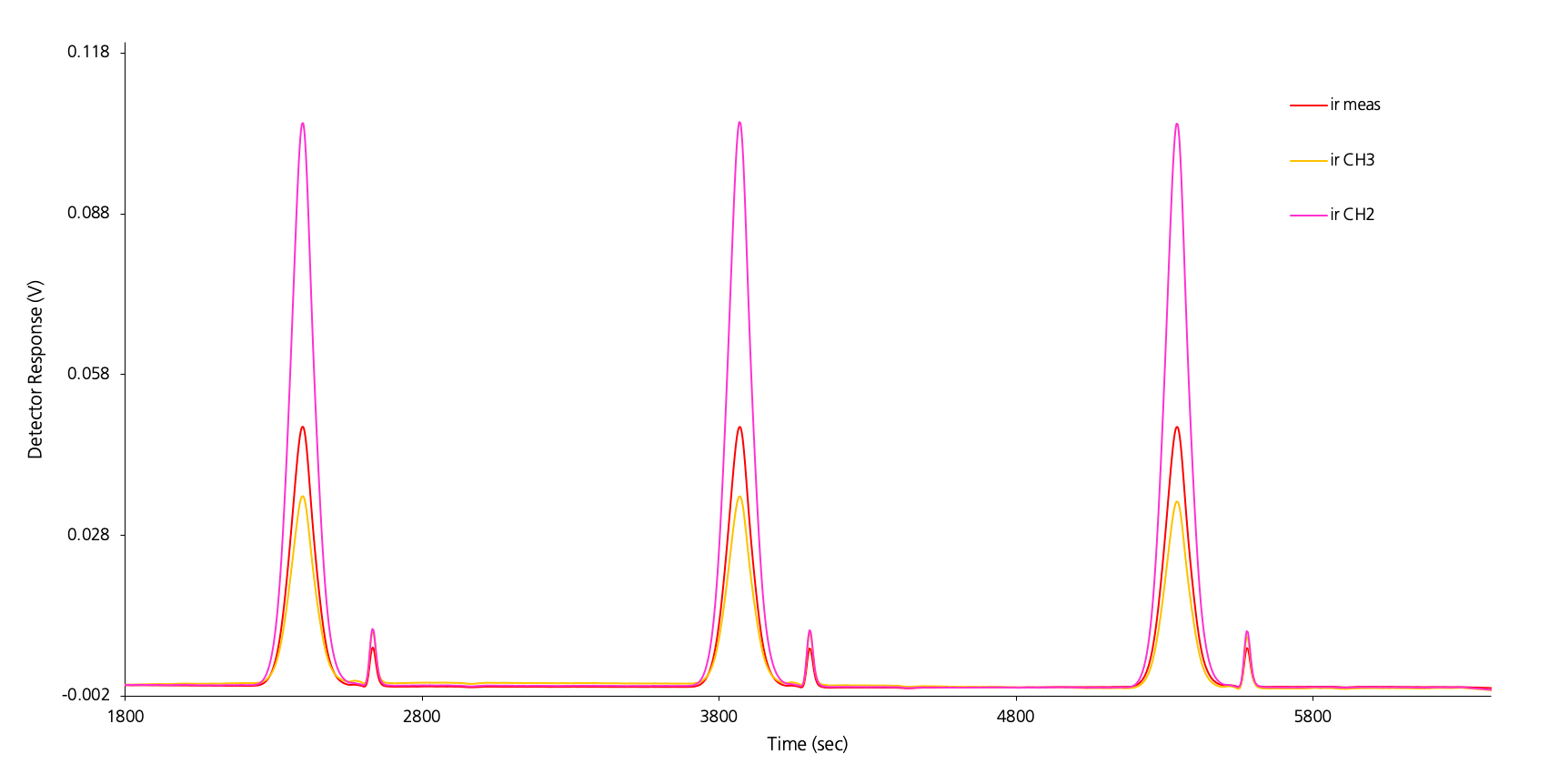
Short stabilization time after flow rate change or oven temperaure variation and outstanding baseline stability ideal for GPC application
Spurious injection peaks usually seen in DRI, do not appear in IR. The baseline is very clean before and after the sample peak which helps in a more precise definition of baseline and integration range. Therefore, consistent values of Mw and Mn are obtained.
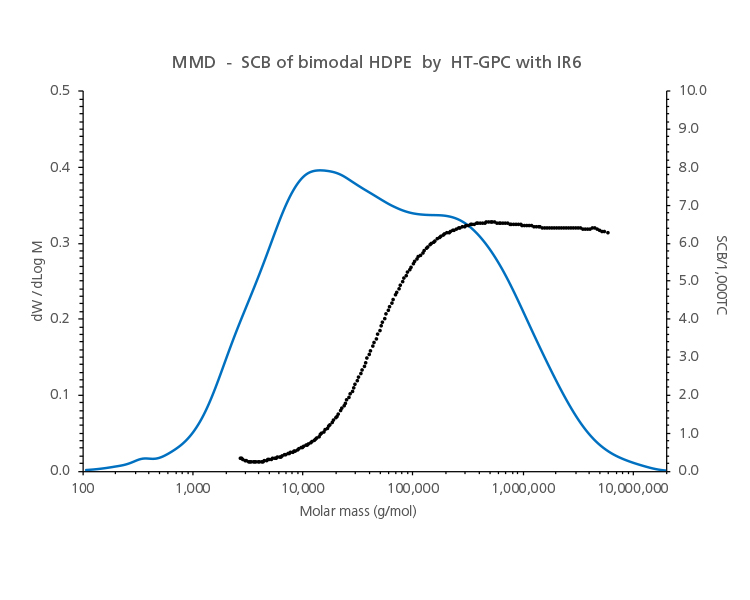
Independent absorbance channels for methyl and methylene groups allow the detection of short-chain branching and variations along the MMD in LLDPE, HDPE, and others. Sensitivity as low as 1 methyl group per thousand carbons allows detection and quantification of small amounts of short chain branching added to the high molar mass fraction of pipe grade bimodal high-density polyethylene (biHDPE).
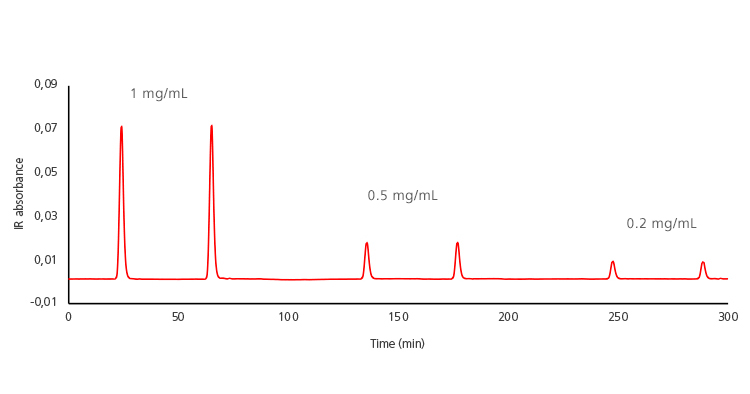
The superb IR6 detector sensitivity and low noise allows reducing the injected mass, by a factor of 10 or more. Required for analysis of highly viscous samples and UHMWPE
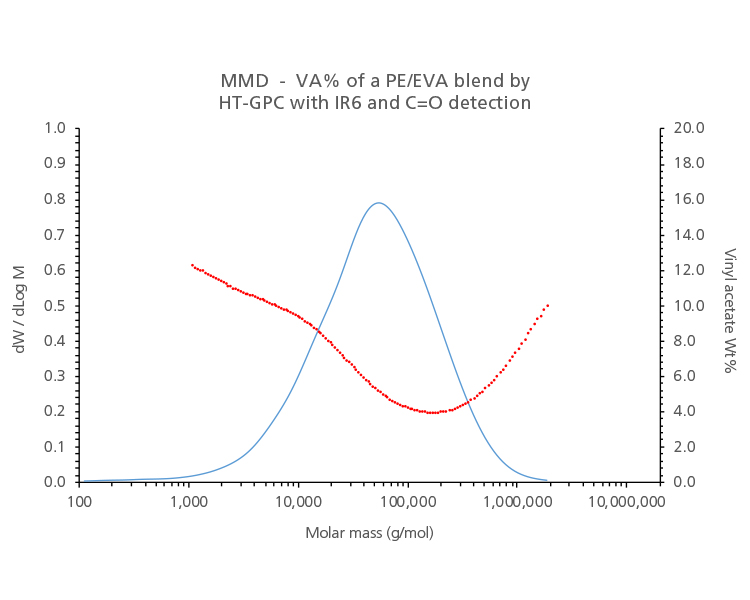
Application to different types of polymers and copolymers beyond polyolefin products such as ethylene-vinyl acetate, ethylene butyl acrylate, and potentially to polycarbonate, styrene-butadiene copolymers, epoxy resins, PET or PBT. Standard and custom filters in the range 2.5 to 6 microns allow the detection of absorbance from different chemical groups. Longer wavelength region is also available on request. A solvent transparent in that spectral region must be used.
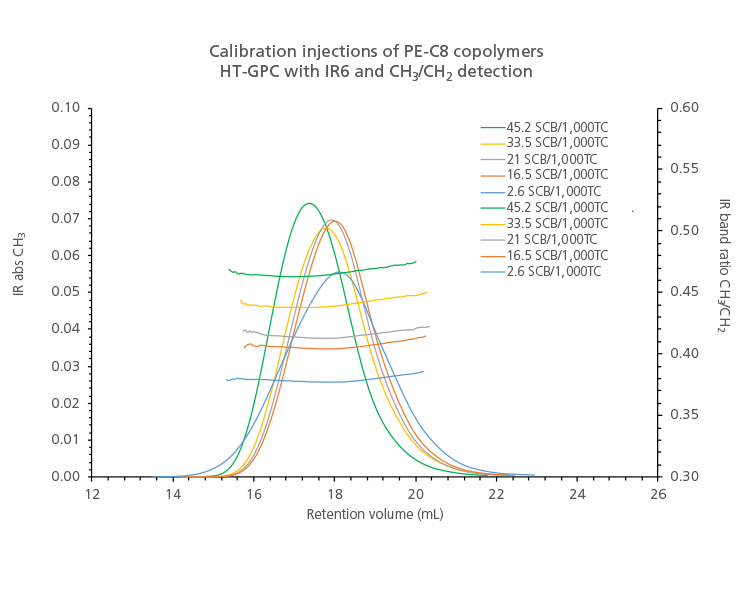
The IR band ratio methyl over methylene is calibrated to SCB or methyl group frequency, while the carbonyl absorbance over methylene absorbance ratio is calibrated to VA weight %. A reduced number of standards (4 - 5 calibration points) is typically used. Therefore, if a change in response is detected, recalibration is easily performed. Different copolymer types or compositional ranges require different fitting order for best accuracy.
A high-performance semiconductive alloy detector, optimized for high sensitivity in the MID-IR spectral range of interest is at the core of the IR6. The operation of this sensitive element below zero degrees is achieved by thermoelectric cooling and an efficient heat evacuation design, which removes the need for using liquid nitrogen as a coolant. Stable optimum operation conditions are maintained on the detector with convenience without interruptions or drifts due to to cooling fluid refills.
The IR6 is an infrared detector with a heated flow-through cell, which uses the principle of infrared absorption spectroscopy at fixed wavelengths, through the use of interference filters, to measure the concentration and composition in polymer solutions.
The continuous signals at different bands in the MID-IR from the multiple filter system included in the detector are provided in real-time, allowing very simple processing and fast analysis applications as high-throughput GPC, and 2-dimensional chromatography.
No, it doesn’t. All the components of the detector were intended for a very robust and simple equipment; that is why thermoelectric cooled detectors were included, avoiding the use of liquid nitrogen.
Any solvent which is transparent in the band of interest and compatible with the detector cell materials: stainless steel, sapphire, and Teflon, etc.
In standard polyolefin applications for concentration and chemical composition based on methyl/methylene ratio both 1,2,4-Trichlorobenzene (TCB), or ortho-dichlorobenzene are typically used.
Detection is possible using any of our recommended solvents (oDCB or TCB), however, oDCB is the preferred option when measuring carbonyl groups.
IR6 is a very sensitive and stable detector for polyolefin concentration so it is used advantageously as main detector in separation techniques when high sensitivity is required.
As chemical composition detector it is used to quantify the methyl frequency (CH3/1000TC) with very good resolution, after proper calibration.
Main application is found in high temperature GPC providing molar mass distribution and short chain branching or comonomer content simultaneously, for all types of polyethylene and propylene, including HDPE with low levels of short chain branching as well as high to ultrahigh polyethylene.
2-dimensional chromatography (SGIC 2D) and analytical cross-fractionation (CFC) also benefit from the high sensitivity of IR6 for detection of even the smallest fractions.
Functional polyolefins and copolymers like EVA, EBA, can also be analyzed by IR6 thanks to the extended spectral range.
Other applications of IR6 are CEF/TREF and TGIC, and in general any solution analytical technique in polyolefin.
As chemical composition detector it is used to quantify the methyl frequency (CH3/1000TC) with very good resolution, after proper calibration.
Main application is found in high temperature GPC providing molar mass distribution and short chain branching or comonomer content simultaneously, for all types of polyethylene and propylene, including HDPE with low levels of short chain branching as well as high to ultrahigh polyethylene.
2-dimensional chromatography (SGIC 2D) and analytical cross-fractionation (CFC) also benefit from the high sensitivity of IR5 MCT for detection of even the smallest fractions.
Other applications of IR5 MCT are CEF/TREF and TGIC, and in general any solution analytical technique in polyolefin.
IR6 is an evolution of the IR5 detector. Some of the optoelectronics components have been modified to extend the spectral range up to the carbonyl band and beyond. The number of available bands simultaneously detected has also been increased from 5 to 6.
Thank you for your interest. If you would like to know more about our detectors or have any question,
please fill out the form below and we will be contacting you.
This site uses cookies to give you a better browsing experience. If you continue
browsing this site we understand that you accept our use of cookies.
For more information,
please visit our Cookies Policy. You can configure which
cookies you accept by ticking the next options: